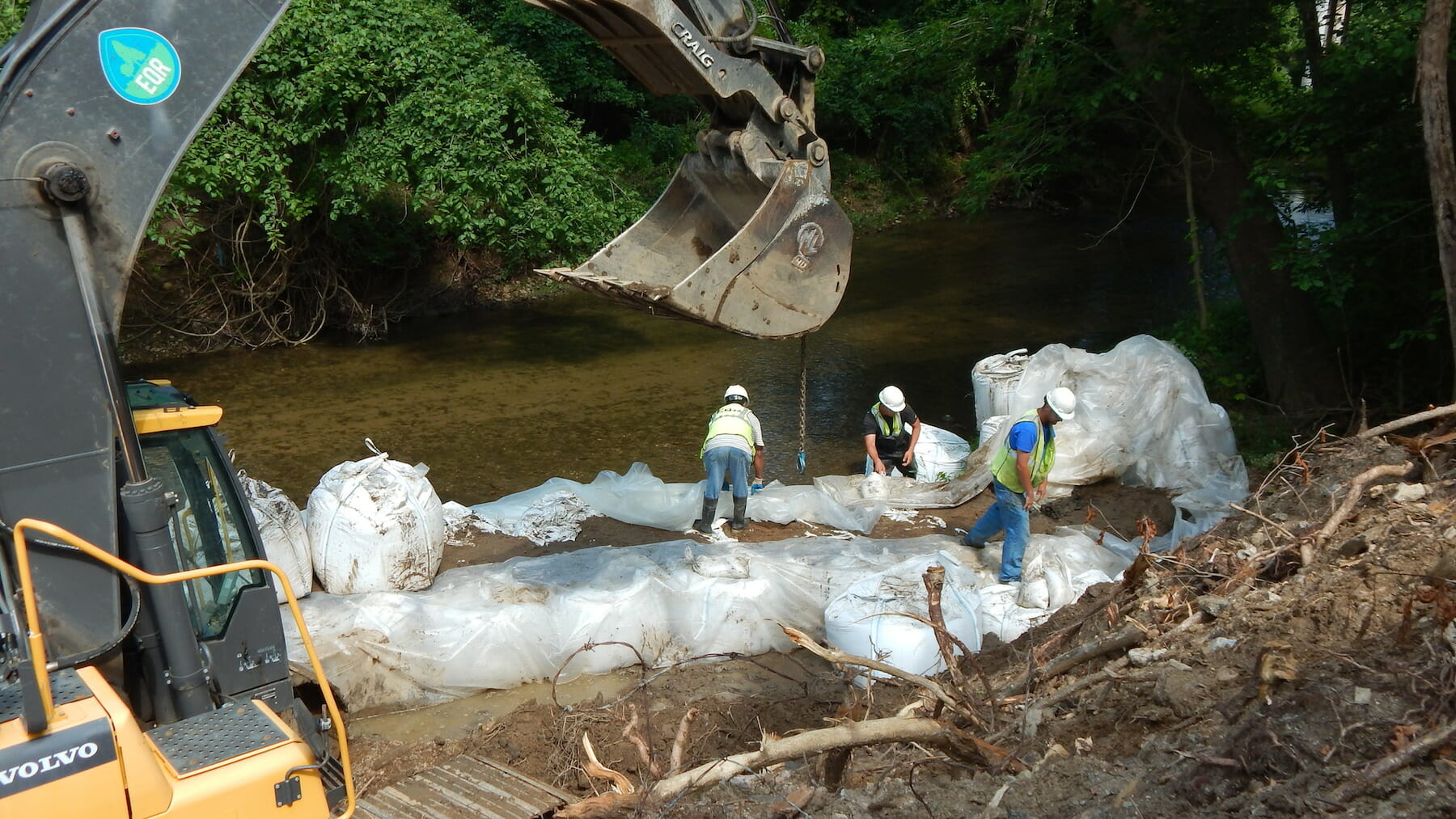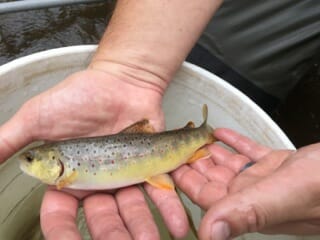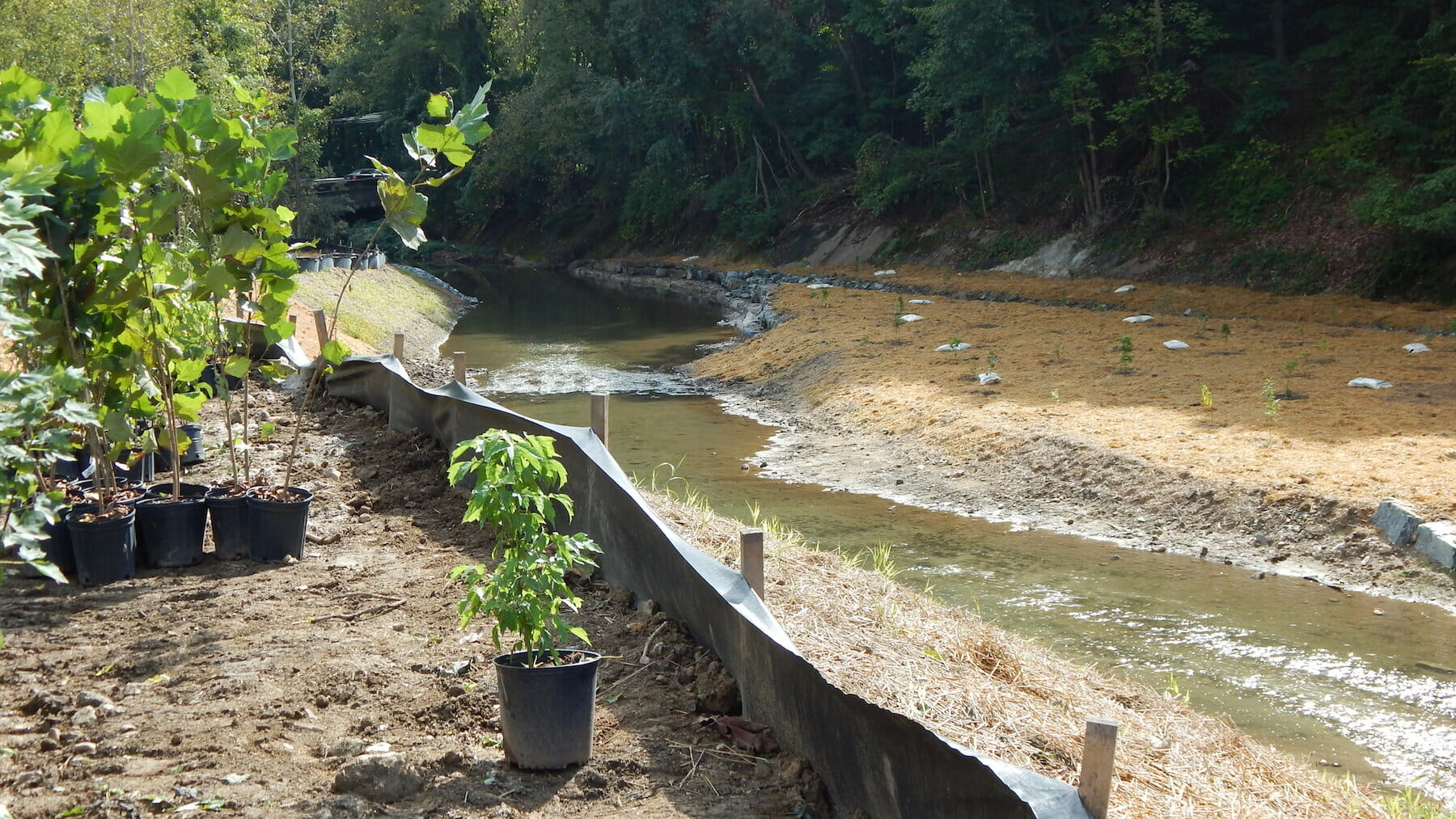Photos courtesty of Bluewater Baltimore
By Don Haynes and Jim Gracie
Over the past five years, Maryland Trout Unlimited has been the mover behind restoration of a long stretch of the Jones Falls in area bordering Baltimore County and Baltimore City.
After a frustrating process, the project was finished in fall, 2015. A steam survey to assess results was conducted in July of 2017 and the initial results were encouraging, showing that wild trout are utilizing the restored reach of stream.
Jones Falls is a spring-fed stream that has its primary source of spring water in the Greenspring Valley in Baltimore County. The watershed is relatively undeveloped: Land use in the valley is primarily large estates. The mainstem of Jones Falls flows approximately 6.5 miles east from Garrison Forest Road to Falls Road, where it turns south paralleling Falls Road for about 2.5 miles.
Fish population surveys by the Maryland Department of Natural Resources, Fisheries Service have documented the highest standing crop of wild trout of any stream in Maryland.
The Jones Falls watershed is excellent habitat for brown trout because marble and limestone found naturally in its bed keep its waters cool enough for the hardier species.
“It’s very rare to have a strong trout population that close to an urbanized area and to have wild trout inside of the Baltimore Beltway,” said DNR fisheries biologist Mark Staley. “Trout and lots of urbanization usually are mutually exclusive.”
The Maryland Chapter has a long history with the Jones Falls. As one of the first acts after the chapter formed (1973) MDTU joined forces with the Greenspring Valley Garden Club to adopt Jones Falls under the Save Our Streams, “Adopt a Stream” program.

Activities over the years included an annual litter cleanup, a water quality monitoring program in which students from seven schools in the Greenspring Valley were recruited and trained to collect water samples and make observations weekly to document water quality and habitat conditions. The chapter also conducted an annual fish population survey, a watershed-wide stream walk and a snapshot of Falls.
As part of the 2009-2014 MDTU Strategic Plan, the Chapter adopted the Jones Falls as its major resource effort. The new project focused on property owned by Baltimore City. The section is located on the west side of Falls Road immediately upstream of the Falls Road bridge over Jones Falls.
The section of stream adjacent to the Baltimore City property had been channelized and lined with a concrete channel in the past. The site was the home of Rockland Bleach and Dye. Repeated flooding of the area prompted the manufacturer to abandon the site leaving behind approximately 600 feet of concrete channel that eliminated any habitat for aquatic life.
MDTU proposed to remove concrete and restore natural stream channel from this reach so that natural stream habitat could be restored using a natural channel design approach. The redesigned channel would have stream banks vegetated with native plants as well as pools and riffles that are natural in a stream. MDTU envisioned that when the project was complete, there would be a natural channel and outstanding habitat.
MDTU successfully secured $425,000 in funding to complete the project.
Partners in the project included Baltimore County Department of Environmental Protection and Resource Management (DEPRM), Baltimore City Department of Recreation and Parks, and the Maryland DNR Fisheries Service. MDTU contracted with Brightwater, Inc. a local firm with more than 26 years experience in natural channel stream restoration. Brightwater successfully completed the design phase that was approved by all parties. MDTU and Brightwater obtained all necessary permits to begin work.
At the last minute, the City of Baltimore demanded a $1,000,000 environmental performance bond. MDTU was unable to meet this requirement and feared the project would be shelved. However, the project was taken over by BlueWater Baltimore and Environmental Quality Resources, Inc. MDTU retained monitoring responsibilities
The project was completed in September of 2016. Tree planting was completed shortly after and MDTU, which retained responsibility for stability monitoring, conducted the first monitoring training and survey in October of 2016. Brown trout were observed holding in the restored section in October 2016.
In July, 2017 MDTU members joined forces with Maryland Department of Environment and BlueWater Baltimore to survey stream progress, including though electroshocking.
Weather conditions were not optimal. The day scheduled for the shocking was on the tail end of several consecutive days when air temps approached 95 degrees or higher, and heat indices soared to the 105 range. Water temp in the section was measured at 70 degrees.

Fish were found primarily in the more oxygenated long riffle at the head of the new pool and DNR uncovered some trout holding in the upper riffles. Four small trout were caught and measured but a lot of baitfish were found.
The trout all appeared to be about the same year/size class, they were most likely 1 1/2 to 2 1/2 year old brown trout that were spawned somewhere upstream of the restoration site.
Mark Staley (DNR) said: “I suspect as the restoration ages and more woody debris moves into the restored channel, habitat for trout will only get better and more complex.”
Monitoring efforts will continue in future years.
Dean Perdue, Brian Bernstein, Jim Grace, Darin Crew and Katie Blizzard from MDTU joined in the effort.



